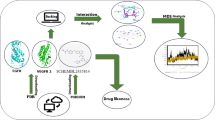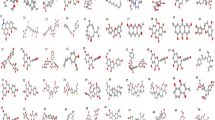Abstract
A series of novel 7-azaindole (1a–j) and 7-azaisatin (2a–j) derivatives were screened for their in vitro breast, lung and liver cytotoxic activities against MCF-7, A549 and HEPG2 cell lines, respectively, by MTT assay method. Among them, compounds 1h, 1i, 2h and 2i have shown good breast cytotoxic activity, and compounds 1h and 1i showed good lung cytotoxic activity and liver cytotoxic activity. These derivatives were also subjected to molecular docking study to investigate the mode of binding with the EGFR kinase, and the compounds showing similar type of docking score and binding patterns with that of the existing drug molecules such as gefitinib. 3D-QSAR studies were done using V-Life Sciences MDS 4.3 drug designing module to explain the structural requirements for the anticancer activity. Since compounds 1h and 1i exhibited high potent activity against MCF-7, A549 and HEPG2 cell lines, they could be effective epidermal growth factor receptor kinase inhibitors.
Graphical Abstract










Similar content being viewed by others
References
Ajmani S, Karanam S, Kulkarni SA (2009) Rationalizing protein ligand interactions for PTP1B inhibitors using computational methods. Chem Biol Drug Des 74:582–595
Berridge MV, Tan AS (1993) Characterisation of the cellular reduction of 3-(4,5-dimethylthiazol-2yl)-2,5-diphenyltetrazolium bromide (MTT): subcellular localization, substrate dependence, and involvement of mitochondrial electron transport in MTT reduction. Arch Biochem Biophys 303:474–482
Berridge MV, Herst PM, Tan AS (2005) Tetrazolium dyes as tools in cell biology: new insights into their cellular reduction. Biotechnol Ann Rev 11:127–152
Dunham W, (2007) Report sees 7.6 million global 2007 cancer deaths. American Cancer Society, Washington. http://www.reuters.com/article/idUSN1633064920071217
Fatima I, Ahmad I, Anis I, Malik A, Afza N (2007) Isatinones A and B, New antifungal oxindole alkaloids from Isatis costata. Molecules 12:155–162
Gehlhaar DK, Verkhivker GM, Rejto PA, Sherman CJ, Fogel D et al (1995) Molecular recognition of the inhibitor AC-1343 by HIV-l protease: conformationally flexible docking by evolutionary programming. Chem Biol 2:317–324
Gullick WJ (1991) Prevalence of aberrant expression of the epidermal growth factor receptor in human cancers. Br Med Bull 47:87–98
Kritsanida M, Magiatis P, Skaltsounis AL, Peng Y, Li P, Wennogle LP (2009) Synthesis and antiproliferative activity of 7-azaindirubin-30-oxime, a 7-aza isostere of the natural indirubin pharmacophore. J Nat Prod 72:2199–2202
Mosmann T (1982) J Immunol Methods 65(1–2):55–63
Pao W, Miller V, Zakowski M et al (2004) EGF receptor gene mutations are common in lung cancers from never smokers and are associated with sensitivity of tumors to gefitinib and erlotinib. Proc Natl Acad Sci USA 36:13306–13311
Prakash CR, Raja S, Saravanan G (2010) Synthesis characterization and anti-inflammatory activity of novel Schiff base of isatin derivatives. Int J Pharm Sci Biotech 1:105–112
Rottmann M, McNamara C, Yeung BKS, Lee MCS, Zou B, Russell B, Seitz P, Pluoffe DM, Dharia NV, Tan J, Cohen SB, Spencer KR, Gonalez-Paez GE, Lakshminarayana SB, Goh A, Suwanarusk R, Jegla T, Schmitt EK, Beck HP, Brun R, Nosten F, Renia L, Dartois V, Keller TH, Fidock DA, Winzeler EA, Diagana TT (2010) Spiroindolones, a potent compound class for the treatment of malaria. Science 329:1175–1180
Sriram R, Sesha Sai Pavan Kumar CN, Raghunandan N, Ramesh V, Sarangapani M, Rao VJ (2012) AlCl3/PCC-SiO2-promotedoxidation of azaindoles and Indoles. Synth Commun 42:3419–3428
Tatsugi J, Zhiwei T, Tsuchiya Y, Takayoshi I (2009) Halogenation of 1-alkyl-7-azaisatins using N-halosuccinimides: regioselective synthesis of 1-alkyl-5-halo-7-azaisatins. Arkivoc 2:132–137
Varma RS, Nobles WL (1975) Antiviral antibacterial and antifungal activities of isatin N-Mannich bases. J Pharm Sci 64:881–882
Verkhivker GM, Bouzida D, Gehlhaar DK, Rejto PA, Arthurs S et al (2000) Deciphering common failures in molecular docking of ligand–protein complexes. J Comput Aided Mol Des 14:731–751
Verma M, Pandeya SN, Singh KN, Stables JP (2004) Anticonvulsant activity of Schiff bases of isatin derivatives. Acta Pharm 54:49–56
Vine KL, Locke JM, Ranson M, Pyne SG, Bremner JB (2007) An investigation into the cytotoxicity and mode of action of some novel N-alkyl-substituted isatins. J Med Chem 50:5109–5117
Wood ER, Kuyper L, Petrov KG, Hunter RN, Harris PA, Lackey K (2004) Discovery and in vitro evaluation of potent TrkA kinase inhibitors: oxindole and azaoxindoles. Bioorg Med Chem Lett 14:953–957
World Health Organization (2006) Reproductive Health, World Health Organization. Chronic Diseases & Health Promotion. Comprehensive cervical cancer control: a guide to essential practice. World Health Organization
Yardern Y, Ullrich A (1988) Growth factor receptor tyrosine kinases. Annu Rev Biochem 57:443–478
Yasuda H, Park E, Yun CH, Sng NJ, Lucena-Araujo AR, Yeo WL, Huberman MS, Cohen DW, Nakayama S, Ishioka K, Yamaguchi N, Hanna M, Oxnard GR, Lathan CS, Moran T, Sequist LV, Chaft JE, Riely GJ, Arcila ME, Soo RA, Meyerson M, Eck MJ, Kobayashi SS, Costa DB (2014) Structural, biochemical, and clinical characterization of epidermal growth factor receptor (EGFR) exon 20 insertion mutations in lung cancer. Sci Transl Med 26:225–247
Zwick E, Bange J, Ullrich A (2001) Receptor tyrosine kinase signalling as a target for cancer intervention strategies. Endocr Relat Cancer 8:161–173
Acknowledgments
We are thankful to Indian Institute of Chemical Technology (IICT) and thank the director, IICT, and the head of the Division Organic II for encouragement. Authors J.R and M.S thank the University Grants Commission, New Delhi, for project, and R. S. thanks the Department of Science and Technology (Inspire), New Delhi, for fellowships.
Author information
Authors and Affiliations
Corresponding author
Ethics declarations
Conflict of interest
The authors declare that there is no conflict of interest.
Rights and permissions
About this article
Cite this article
Rekulapally, S., Jarapula, R., Gangarapu, K. et al. In silico and in vitro studies of novel 7-azaindole and 7-azaisatin derivatives as potent anticancer agents. Med Chem Res 24, 3412–3422 (2015). https://doi.org/10.1007/s00044-015-1390-0
Received:
Accepted:
Published:
Issue Date:
DOI: https://doi.org/10.1007/s00044-015-1390-0




